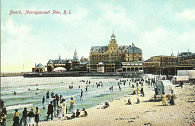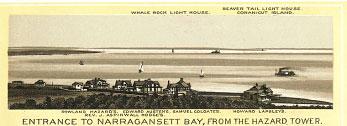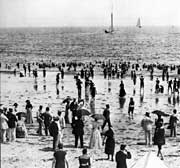 | ||||||
 |
History and CultureIndustrial/VictorianImmigration:There was a large influx of non-English European immigrants during the Industrial Era. Starting from the mid-1820s, there was a large population of Irish Catholics immigrating to Rhode Island. They came to work on public works projects such as Fort Adams in Newport and the railroads or they worked in the textile mills and metal factories. Following the Irish Catholics, the French Canadians came to Rhode Island in large numbers. English, Irish, Scottish, Polish, Italians, and the Portuguese all came over to Rhode Island during the 19th century. Slavery:With the end of the international slave trade in 1808, salves were still traded internally in Rhode Island to maintain plantations of South County and to work in the summer cottages along the Newport coast. Recreation:The availability of the soft-shelled clam, Mya arenaria, began a new type of recreational activity, clam digging. Clam digging at low tide, first done by the Native Americans, became very popular along the coast of the Narragansett Bay.
Boating also became a recreational activity, more and more people owned boats of all sizes that began to fill the Bay. During the 19th century, the first yacht clubs were formed. Along the coast of Narragansett, the Pier and Casino offered wealthy summer residents with new forms of recreation. The train from Providence, Rhode Island's capital city brought residents into Narragansett by the hundreds.  "Beach, Narragansett Pier, RI" (Courtesy of South Kingston Public Library, Peacedale, RI) Click for larger version. Summer Homes:In the mid-19th century, a real estate boom occurred and the first of the grand 'summer cottages' were built. Visitors realized that along the coast was a more pleasing view and was cooler than the cities, therefore they began to build along the upper and mid-Bay.  "Entrance to Narragansett Bay, from the Hazard Tower" (Courtesy of South Kingston Public Library, Peacedale, RI) (Click for larger version). Tourism:Newport and Narragansett became attractive sites for tourism. Many hotels, inns, restaurants, and bathing beaches were appealing to people. And due to the new railways and steamboat lines these places were easily accessible. The Narragansett Pier and Towers Casino also became a site for tourists to visit.  "Narragansett Pier, 1890" (Courtesy of the Providence Public Library) (Click for larger version). Natural Resources:The oyster business was once Narragansett Bay's most notable fishery. The oysters found in the Bay gained a reputation among gourmets. Oysters were found in coves, salt ponds, and tributaries. The oyster business slowly came to an end during the late industrial era due to predators such as starfish and mussels, poachers, and pollution entering into the Bay from the Providence River. The Narragansett Bay also offered such natural resources as fish that were used for fertilizer. Farmers harvested salt hay from the marshes and driftwood found along the coastline was collected and sold. The 1880s was a good period for fisheries, providing a cross-section of many fish. Included were alewives, sea bass, tautog, bluefish, cod, eels, flounder, mackerel, salmon, and swordfish. Top of Page
|
|||||
